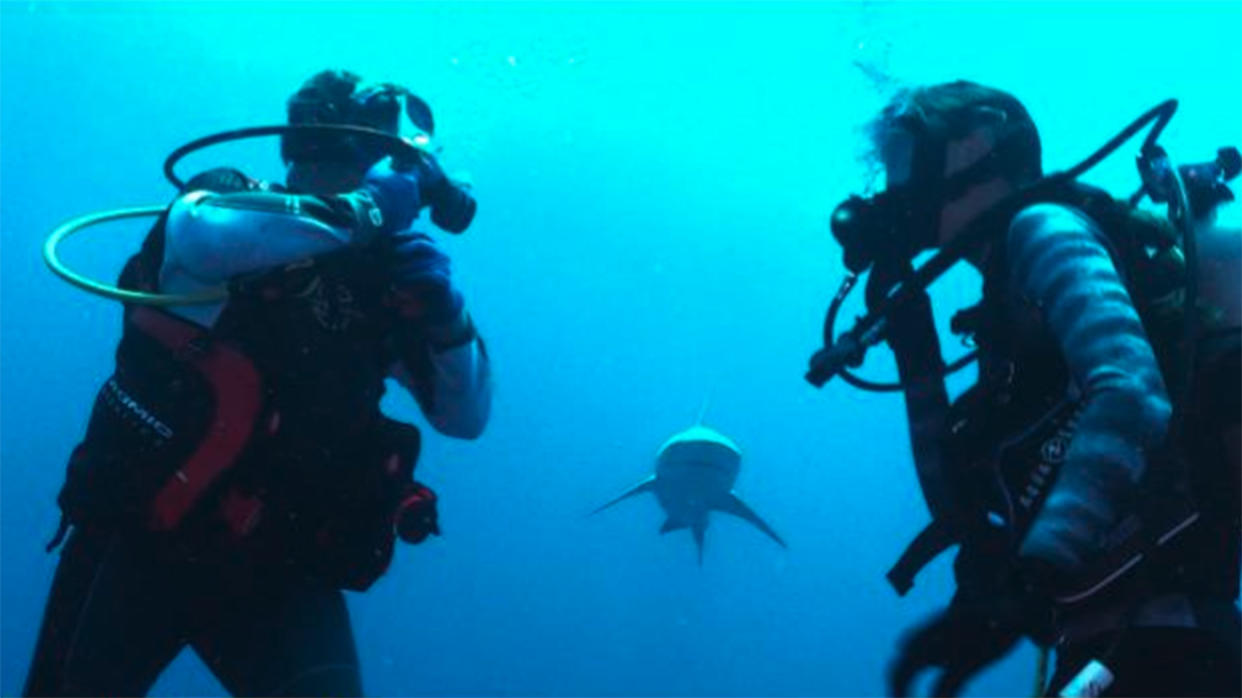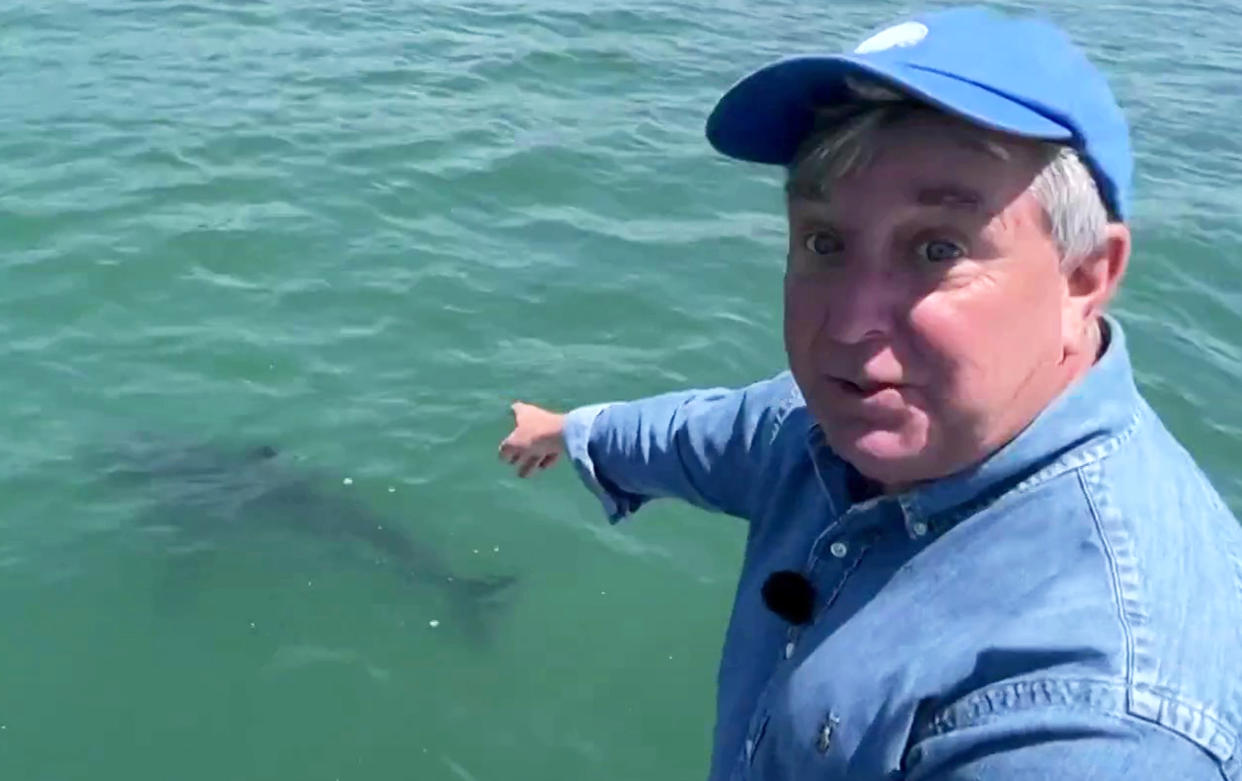I’ve Been Swimming With Sharks For Years. Here’s What I’ve Learned
The first time I saw a shark I was in shallow water.
I was at most 10 feet under, at “Stingray City” in Grand Cayman.
Snorkeling would have been fine, but thankfully I had scuba gear so that I could watch the approaching hammerhead without the need to surface and gulp a fresh breath of air.
With my eyes wide open, I watched as the shark moved with grace and speed. It was headed directly toward me! I was on the edge of panic.
What do I do?
That shark is at least 25 feet long!
It wants to eat me.
I began to breathe heavily. And the shark? It purposely moved toward me and then zigzagged right past me and away.
As I watched the shark disappear in the water, I had proof positive of what I’d long been told by marine biologists: “Sharks don’t hunt humans.”
I also realized something else: That shark was really only about 12 feet long. Big, yes — but not what I was certain I had seen in the moment. It’s funny what your imagination can do, even when you’re snout-to-face with reality.

I had to head back to shore right away. It wasn’t to get my bearings or to process the experience. Nope, it was because in my near-panic, I had sucked so much air my tank was almost empty. (Dive tanks have air. They’re not oxygen tanks. We’d die if we had pure oxygen.)
I look back on that experience now with a chuckle because I’ve since had the opportunity to dive in various waters that are often called "shark-infested."
I’ve swum with sharks near and far — from the Atlantic Ocean (a 15-minute bike ride from my home in Fort Lauderdale) to the waters of Papua New Guinea, in Australia’s Great Barrier Reef, and beyond.
I’ve also been in controlled settings, like the Oklahoma Aquarium, where I donned a knight’s chainmail suit to swim with bull sharks. (The chainmail was not needed — the sharks ignored me.)

Once, I was surrounded by more than a dozen bull and tiger sharks miles off the coast of Jupiter, Florida. I had gone on a so-called “shark dive.” In federal waters, the boat captain chummed the water with chopped up fish and blood. It was the one time I’ve been hesitant to jump in. I waited. I observed. I waited a little longer, and then I took that leap of faith.
It was at once exhilarating and liberating because I knew there was little I could do if things didn’t turn out the way it has for all the others who have done this before (without incident). Why liberating, you ask? Because when you accept that you have no control, it’s actually a freeing moment to enjoy.
An early interest in sharks
I was a kid when “Jaws” hit the silver screen.
I still remember sitting in the front row at the movie theater in Marlborough, Massachusetts.
I recall one scene as it were yesterday: Actor Roy Scheider is slopping chum off the stern, a cigarette hanging between his lips. His eyes are toward the bow when from the water the shark surfaces, mouth open, gnarly teeth ready to eat every one of us.

I still remember jumping out of my theater seat, yet at the same time being drawn to want to better understand sharks.
My colleagues at TODAY like to call me “the resident shark expert.”
Everything I know about sharks, and what I share in my reports, is what I’ve learned from decades on and beneath the ocean with the marine biologists. Thankfully, they’ve been generous enough to share their time and knowledge with NBC News and me.
Here are some facts we know:
We know sharks don’t get cancer.
We know there are many species of sharks yet to be identified.
We know there is overfishing of sharks.
We know that finning, or cutting off the shark’s crucial fin, makes little sense. I’m told the fin in shark fin soup has no taste but for the broth it’s cooked in. (The soup is popular in some parts of the world because of a long-held belief that eating the shark’s fin promotes virulence, wealth and social status.)
This week we may have learned one more thing: a breakthrough. We have scientists show us where sand tiger sharks may give birth — watch the story on TODAY for that discovery.
Shark attacks in the news
Do swimmers and sharks sometimes interact with devastating consequences? Absolutely.
And to those survivors who share their experiences with me: thank you.
These “attacks” are news for one simple reason: They’re rare.

Many more people are estimated to die from jellyfish stings each year than they are from shark attacks, for example.
Will we see another interaction with potentially fatal consequences? Yes. But should we blame the shark?
Recently 17-year-old Addison Bethea lost her leg when a 9-foot shark bit her as she was hunting scallops in the Florida Panhandle.
Despite the suspected bull shark that attacked her, she told TODAY she didn’t blame the shark for doing what sharks do when we enter their environment.
I was once told the two scariest words in the English language are “cancer” and “shark.”
As we learn more about sharks, that fear may change, but as any swimmer who looks over and sees someone on the beach pointing and yelling “SHARK!” knows, we’re a long way from just a casual shrug.
